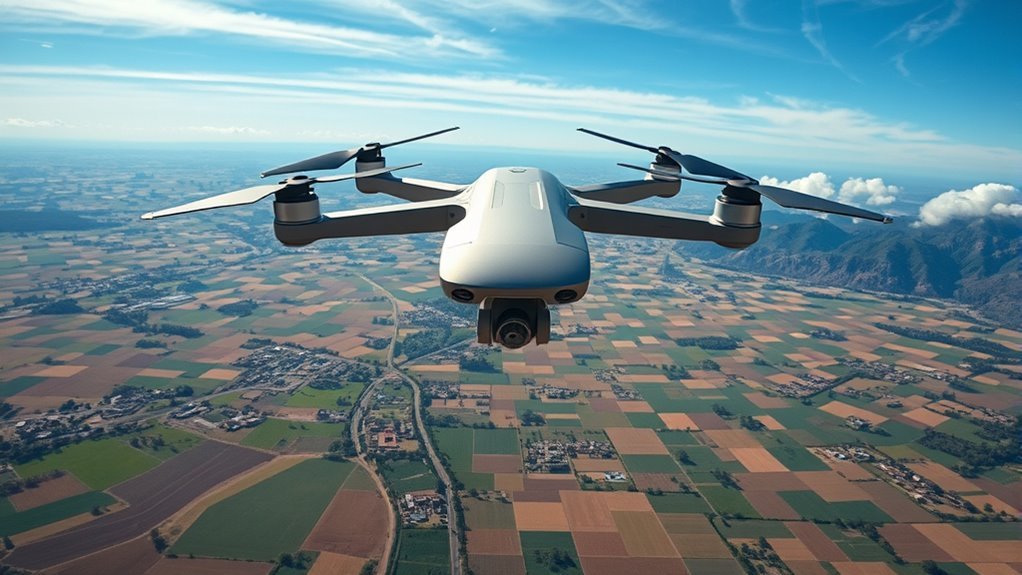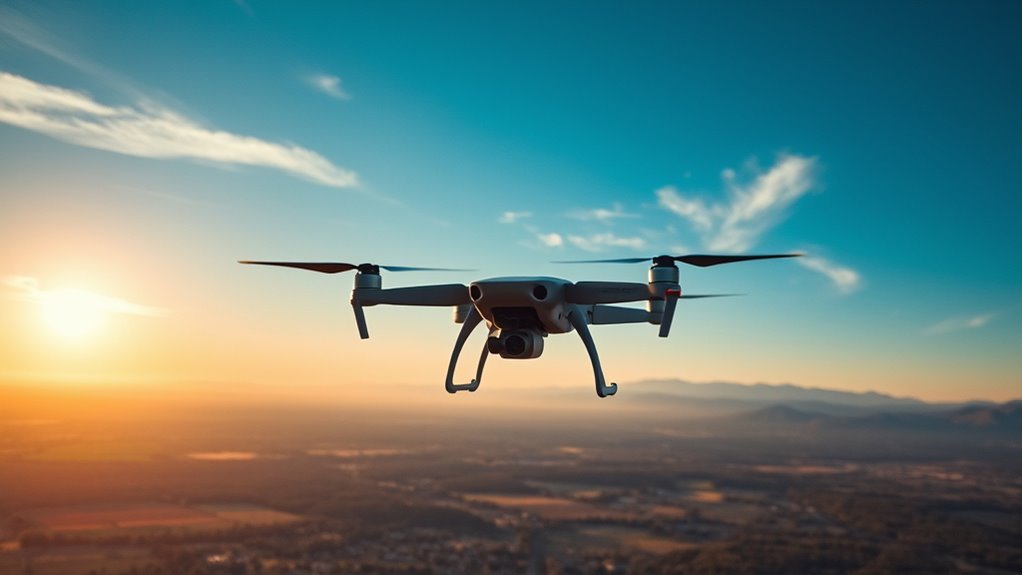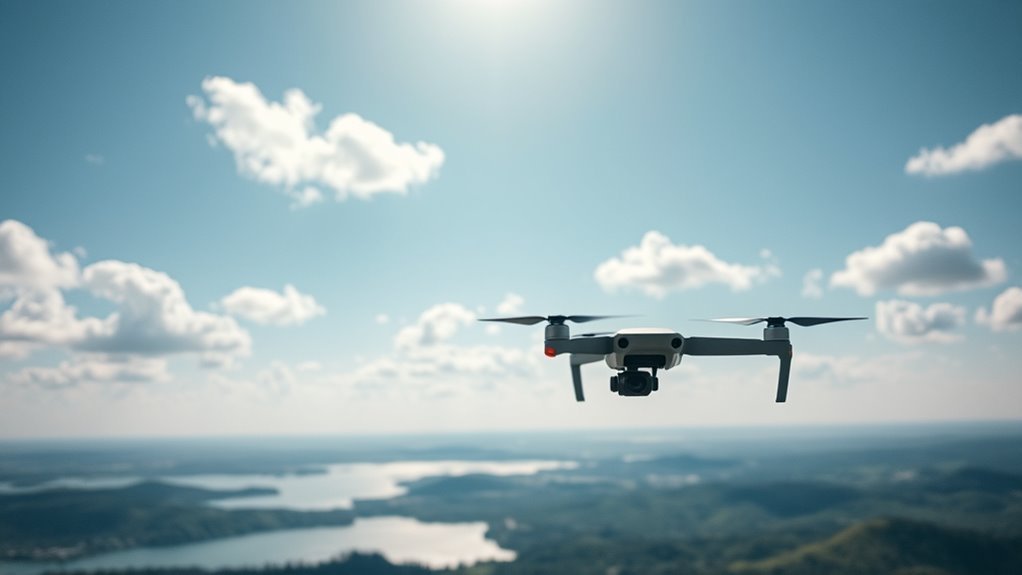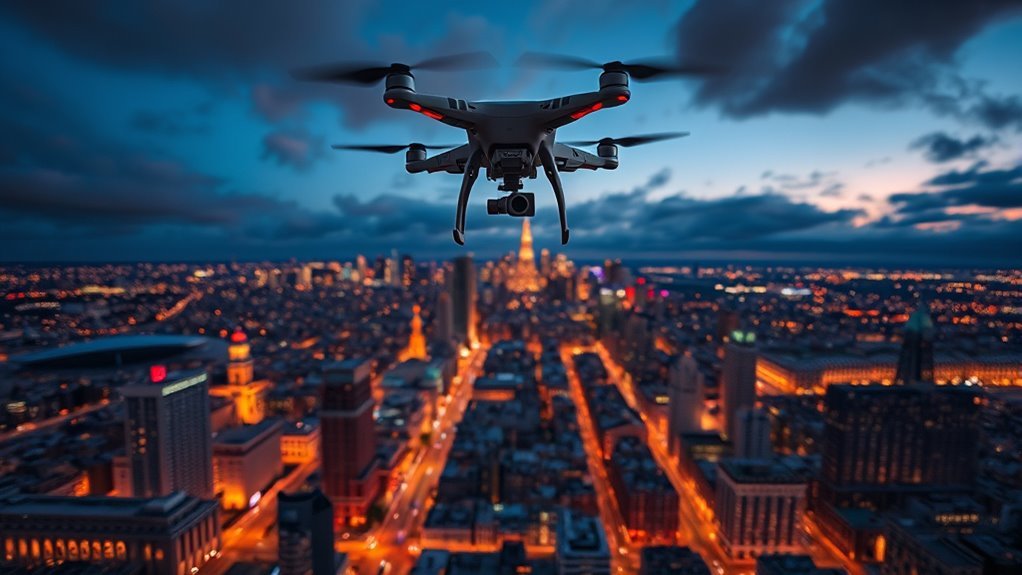In the United States, you can legally fly your drone up to a maximum altitude of 400 feet above ground level. This limit is vital to prevent collisions with manned aircraft. You must also comply with airspace restrictions and local regulations, which could further impact where and how high you can fly. Understanding these guidelines is essential for safe drone operation. Want to learn more about the specific regulations that apply to your flights?
Understanding Drone Regulations

While maneuvering the world of drone operation, it is vital to understand the regulations that govern their use. Knowledge of these regulations not only guarantees compliance but also enhances drone safety. Being aware of altitude restrictions is significant; flying at uncontrolled heights can lead to dangerous encounters with manned aircraft. Familiarizing yourself with local laws helps maintain altitude awareness, allowing you to fly freely while minimizing risks. Always check for no-fly zones and temporary flight restrictions, as these can impact your operations. Embracing these regulations doesn’t limit your freedom; instead, it empowers you to operate your drone responsibly and creatively. Understanding local drone regulations is crucial for flying legally and safely. Ultimately, understanding these guidelines is fundamental to enjoying the exhilarating experience of drone flight while safeguarding safety for everyone involved.
Maximum Altitude Limits for Drones

In the United States, the Federal Aviation Administration (FAA) sets the maximum altitude limit for recreational and commercial drones at 400 feet above ground level. This regulation guarantees altitude safety while allowing you to explore the capabilities of drone technology. Flying above this limit can pose risks, including collisions with manned aircraft, which can jeopardize both your freedom to operate drones and public safety. It’s crucial to respect these altitude restrictions to enhance your flying experience while remaining compliant with the law. By adhering to the 400-foot limit, you can enjoy the full potential of your drone without compromising safety or facing potential penalties. Stay informed and fly smart—your aerial adventures depend on it.
FAA Guidelines for Recreational Drone Pilots

To guarantee a safe and enjoyable flying experience, it’s essential that recreational drone pilots adhere to the FAA’s guidelines. To begin with, you must maintain visual line-of-sight with your drone at all times, ensuring drone safety and altitude awareness. You’re limited to flying below 400 feet, allowing for a safe distance from manned aircraft. Proper power management is crucial for ensuring your drone operates effectively within the allowed range. Avoid flying near airports or in restricted airspace, as this could lead to dangerous situations. Additionally, always check local regulations, as they may vary. Keep your drone within a 3-mile radius of your home base to maintain control. Finally, never fly over people or moving vehicles. By following these guidelines, you can enjoy the freedom of flying while prioritizing safety for yourself and others. It’s also important to be aware of state and local laws that may impose additional altitude restrictions beyond federal guidelines.
Commercial Drone Flight Restrictions
When operating commercial drones, you’re subject to specific flight restrictions that differ from recreational use. You’ll need to be aware of maximum altitude regulations, airspace classification guidelines, and the requirements for special permits. Understanding these factors is essential for ensuring compliance and safe operation in various environments.
Maximum Altitude Regulations
While understanding the maximum altitude regulations is essential for safe commercial drone operations, it’s important to recognize that these limits are primarily set by aviation authorities. Generally, the maximum drone altitude is capped at 400 feet above ground level, ensuring that flight safety is maintained and minimizing risks to manned aircraft.
- Compliance with local laws prevents fines.
- Staying within drone altitude limits enhances safety.
- Operating below 400 feet reduces collision risks.
- Awareness of regulations promotes responsible flying.
Airspace Classification Guidelines
Understanding airspace classification guidelines is essential for anyone operating drones commercially, as these regulations dictate where you can legally fly. The airspace is divided into different classes, each with specific rules regarding drone altitude and operations. For instance, Class G airspace allows for more freedom, but you must remain vigilant about nearby airspace boundaries, particularly when moving into controlled airspace like Class B, C, or D. These classes impose altitude restrictions and may require prior authorization for commercial drone flight. Knowing these classifications is vital to avoid legal issues and guarantee safe operations. Always check local regulations and airspace maps before flying, as compliance enhances both your freedom and responsibility as a drone operator.
Special Permits Requirements
To operate drones commercially in certain circumstances, you may need special permits that go beyond standard regulations. Steering through the application process for these permits can seem intimidating, but it’s essential for compliance and safety. Here are some common scenarios where special permits are required:
- Flying beyond visual line of sight (BVLOS)
- Operating at night or in controlled airspace
- Conducting commercial operations over populated areas
- Utilizing drones for delivery services
Each of these scenarios demands meticulous preparation and adherence to specific guidelines. Failing to secure the necessary permits can lead to penalties, so stay informed and proactive. Embracing these requirements not only enhances safety but also broadens your operational capabilities, allowing you to explore the skies with confidence.
Airspace Classes and Their Impact on Drone Altitude
Airspace classification plays an essential role in determining how high drones can fly legally, as each class of airspace has specific regulations that govern drone operations. You’ll need to be aware of the airspace restrictions that apply to your flight location. For instance, Class G airspace allows for more freedom, permitting drone flights up to 400 feet, while Class B and C airspaces impose stricter limitations, often requiring altitude awareness and permission to operate. Understanding these distinctions is imperative for achieving your operational goals while staying compliant. By familiarizing yourself with the various airspace classifications, you can navigate the skies confidently, ensuring your drone activities remain within legal parameters and aligned with safety standards.
Special Use Airspace and Drone Operations
Here are key points to take into account:
- Military Operations Areas (MOAs): Restricted zones where military training occurs. These areas often have specific regulatory design tweaks that drone manufacturers must implement to ensure compliance.
- Temporary Flight Restrictions (TFRs): Established for events like natural disasters or VIP movements.
- Prohibited Areas: Designated spaces where no drone flights are allowed, often around sensitive sites.
- Warning Areas: Areas outside U.S. airspace where activities may be hazardous to aircraft.
Additionally, drone operators must be aware of no-fly zones that exist around certain locations, such as airports, to ensure compliance with local regulations.
Local Laws and Ordinances Affecting Drone Flight
Although federal regulations set the groundwork for drone operations, local laws and ordinances can greatly impact where and how you can fly. You’ll need to familiarize yourself with local regulations and municipal ordinances, as they often impose zoning restrictions that dictate allowable flight zones. Additionally, state laws might include specific noise regulations and wildlife protections that affect your operations. Be aware of privacy concerns, as some areas may have stringent rules regarding drone surveillance. Furthermore, compliance with drone registration is essential to ensure you are operating within legal boundaries. Non-compliance can lead to enforcement actions, so always verify your drone registration is up to date. Understanding these local nuances is essential to exercising your freedom while maneuvering the skies responsibly. Always check your local laws to avoid unintended violations. Moreover, Connecticut’s drone regulations emphasize responsible usage, highlighting the importance of complying with both federal and state laws.
Consequences of Violating Altitude Regulations
Failing to adhere to altitude regulations can lead to serious consequences, impacting both your operations and safety. Ignoring these rules isn’t just risky; it can also trigger legal penalties and enforcement actions that you definitely want to avoid. Here’s what you might face:
- Fines: Substantial monetary penalties can hit your wallet hard.
- License Suspension: Your drone pilot license could be suspended or revoked.
- Seizure of Equipment: Authorities may confiscate your drone as part of enforcement actions.
- Legal Action: You could face lawsuits from individuals or organizations affected by your violation.
Understanding and respecting altitude regulations isn’t just about compliance; it’s key to maintaining your freedom to fly.
Best Practices for Safe and Legal Drone Flying
To guarantee safe and legal drone flying, it’s essential to familiarize yourself with the regulations governing altitude limits and operational zones. Here are some flight best practices to secure drone safety:
| Practice | Description | Benefits |
|---|---|---|
| Pre-Flight Checklist | Always conduct a thorough inspection before flying. | Reduces mechanical failures. |
| Stay Below Altitude | Respect altitude limits set by regulations. | Avoids legal issues. |
| Maintain Line of Sight | Keep the drone in sight during operation. | Enhances control. |
| Respect Privacy | Avoid flying over private properties without permission. | Builds community trust. |
Additionally, it is important to note that drones must be flown only in designated areas within national forests to ensure compliance with regulations. Environmental factors can also impact signal penetration, affecting drone performance and safety.
Frequently Asked Questions
Can I Fly My Drone Higher Than the Legal Limit for Photography?
You can’t exceed drone altitude regulations for aerial photography. Staying within these limits guarantees safety and compliance. Ignoring them could lead to fines and jeopardize your ability to fly freely in the future.
What Is the Process for Applying for Altitude Waivers?
If you’re seeking a waiver application, start by studying altitude regulations. Submit your request, detailing purpose and safety measures. It’s a meticulous process, but with proper planning, you can achieve your aerial ambitions.
Are There Any Restrictions for Flying Drones at Night?
You need to follow night flying regulations carefully. Make certain your drone’s equipped with appropriate lights and maintain visual line of sight. Implementing drone safety precautions is essential to avoid accidents and comply with FAA guidelines.
How Do Weather Conditions Affect Legal Drone Altitude?
Weather conditions greatly impact your drone operations, influencing altitude regulations. Strong winds, rain, or low visibility can limit your flying height and safety. Always check forecasts to guarantee compliance and maintain ideal flying conditions for your drone.
Can I Fly My Drone in National Parks?
Imagine a bird soaring freely through vast skies; unfortunately, you’ve got to respect drone regulations. National park policies typically prohibit flying drones, aiming to protect wildlife and preserve natural beauty. Know the rules before you take flight.

